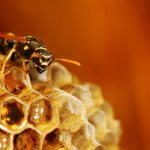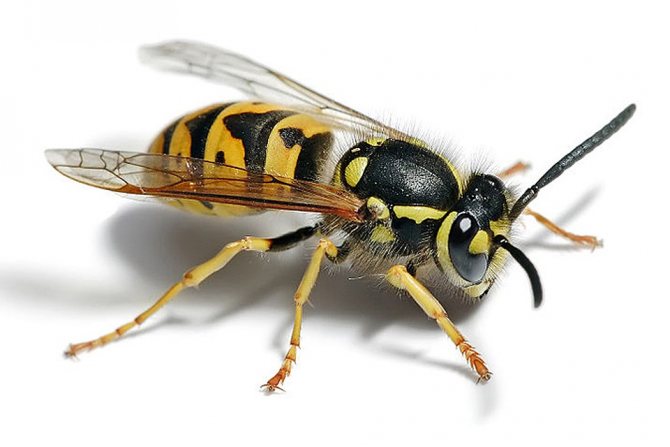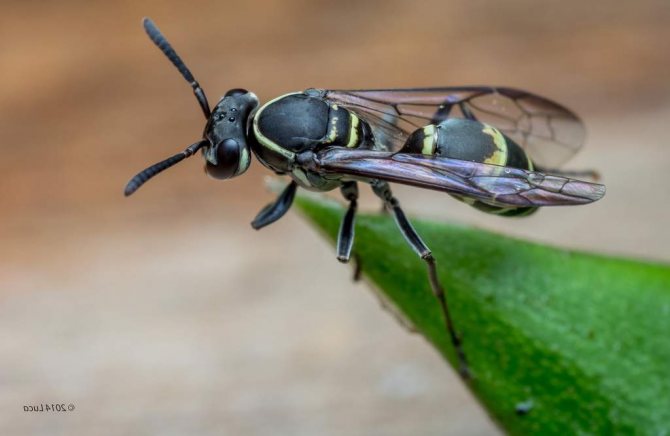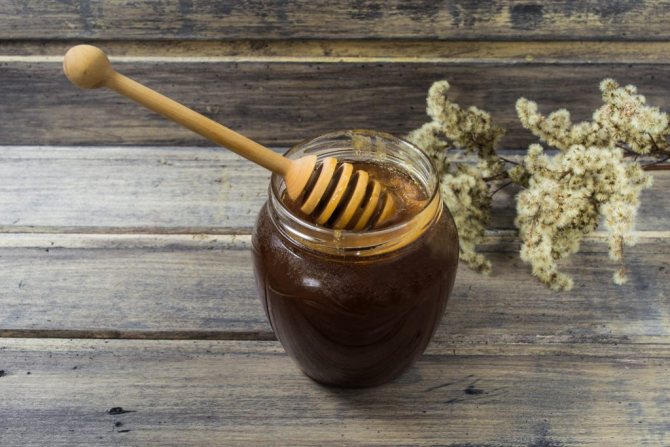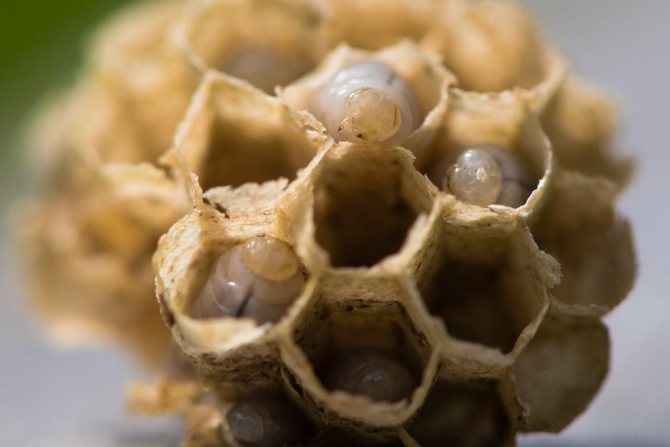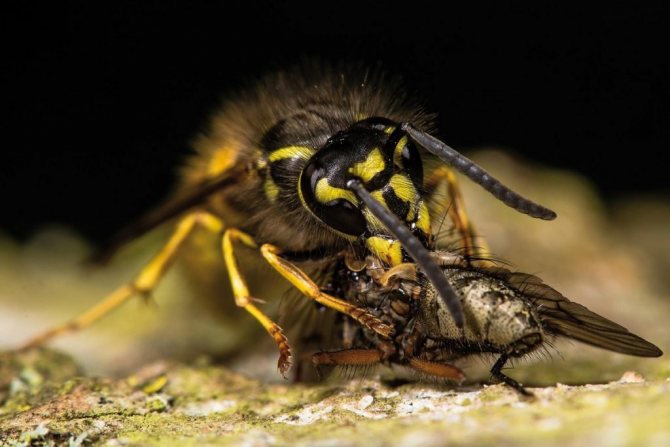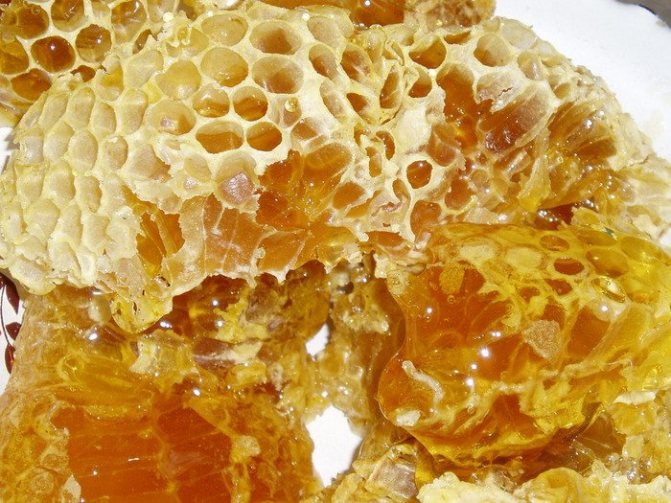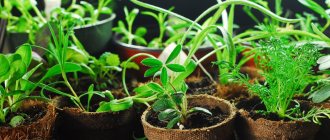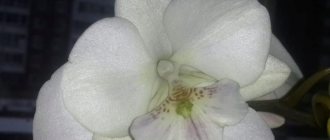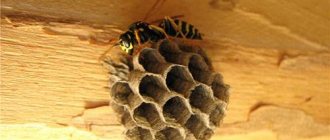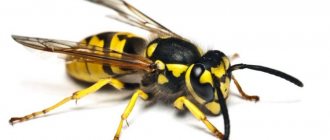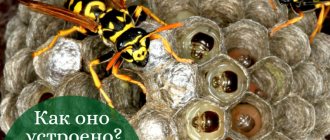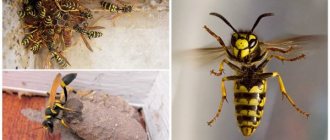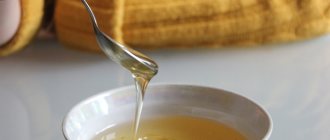"Honey" Is there wasp honey?
0
549
Article rating
Contrary to the opinion that the wasp is a harmful insect, it benefits humans. These creatures are essential in the chain of nature for the development of plants. They pollinate the very first flowering plants, even when the air temperature is not high enough for the bees. They also give wasp honey.
Wasp honey
Wasp honey
The striped insects belong to the same family as the bees, the Hymenoptera. Many people are interested in the question whether wasps collect honey or not, do wasps collect nectar, or can only certain species of insects do this? It is known that on the territory of Central America and in African countries, people are engaged in their breeding in order to obtain wasp honey. The fact is that adults, just like bees, feed on nectar and pollinate flowers. That is why they are also capable of creating honey. The wasp product differs from the bee product in its useful properties, taste characteristics, quality and quantity.
The consistency of aspen honey is very thick, viscous, based on pollen. The smell is quite pleasant. In comparison with bee, which is formed in huge quantities, this product is very small. It contains practically no useful enzymes, while there is plenty of sugar and protein in it. It also contains calcium and minerals. In general, wasp honey does not have a special meaning for the human body.
Is the wasp honey
When asked whether wasps make honey, many will answer unequivocally "no", but not everything is so simple. A species of wasp that is capable of producing sweetness is called Polybia Occidentalis. They not only create a sweet product, but also store it and store it for the winter. Only adults make honey. Their diet includes juices of ripe fruits and vegetables, flower nectar. The larvae feed mainly on protein foods. Parents get small insects, spiders, flies and even bees for them.
Note! It is noteworthy that the wasps prefer to consume the treat rather than create it. Whole families, they attack bee hives, ruining their reserves in one such "raid". They drag the caught bees to their hive and feed them to the larvae. At the same time, they do not take honey, therefore, it practically does not exist in an aspen dwelling.
At the same time, a small layer of honey mass is formed over time on the walls of the hive and in the cells of the honeycomb. Thus, the wasps do not bother themselves with the creation of a sweet product. Sugar bloom forms on its own, usually after the insect has eaten pollen on the flower. It turns out that the answer to the question whether wasps make honey or not is now obvious: no, they don't. But at the same time, another question, whether wasp honey exists, has the right to an affirmative answer: yes, it does.
What does wasp honey taste like?
This product is a single pollen nectar. It accumulates in the wasp combs. The product is very aromatic, fragrant, but crystallizes much faster than bee.
In search of flowers, insects fly around the area and carefully explore it. The fact is that wasps, like bees, try to collect nectar from those plants that are as close to their nest as possible. For this reason, the taste of the product depends mainly on which plants are located next to the wasp hive.
Is it possible to eat wasp honey
Having found out whether the wasps have honey, another logical question arises: can it be consumed as food?
A dense, aromatic mixture of pollen and nectar with a pleasant floral scent contains many plant-based nutrients. However, despite this, the wasp product is significantly inferior to the bee product in many respects. Sweet honey, which, conventionally speaking, is made by wasps, has a pleasant taste and rich aroma, and yet it cannot be compared with the classic version. In addition, the nutritional value, even with a high sugar and protein content, is very low. It contains no enzymes, with the help of which bees process flower nectar and create a product familiar in its taste and consistency.
Important! Wasp honey crystallizes very quickly, losing its viscosity. The taste is not very sweet and, in terms of properties, is not as useful as bee. In fact, it is practically no different from the original raw material - the very nectar that is contained in the flower bud.
The characteristics listed above do not mean at all that wasp honey is forbidden to eat. It is quite edible and healthy to a certain extent. It should also be remembered that a product obtained as a result of collecting flower sap and pollen from poisonous crops can provoke serious poisoning in a person.
Whether to look for honey in an aspen nest in Russia
The Slavic and other peoples living on the territory of Russia have never had such a concept as "wasp honey". This expression was used figuratively, and was also used as the name of alcoholic beverages made on the basis of a beekeeping product.
For your information! The harsh Russian climate, as well as the climate of other countries located close to Russia, is not suitable for melliferous wasp species. And even more so, no one here is engaged in breeding these insects in order to obtain a sweet product.
In common wasp hives, you can see a thin layer of nectar accumulated on the walls of the dwelling. This is nothing more than the result of the collection of flower and fruit juices by insects. However, the total mass of nectar reserves is very small, and only in exceptional cases can it reach 20-30 g. Such a layer, as mentioned earlier, is formed by chance, due to the fact that insects, collecting pollen and nectar for their own consumption, bring their particles to their paws straight into the hive. Over time, the nectar accumulated on the walls of the nest matures and becomes like a classic product.
Bumblebee honey
Do wasps and bumblebees give honey like bees? As for the former, everything is clear with them. Bumblebees collect flower nectar and make honey as a result of its processing. Since insects do not carry out volumetric reserves, the amount of sweetness is small. The main purpose of bumblebee nectar is to feed the larvae and maintain the vital processes of the entire hive.
For humans, this product is very useful, since its quantity is very limited, and the benefits for the body are undeniable. Bumblebee honey is a very expensive and rare product.
Few people are engaged in its extraction, and therefore it can be very false to find a seller. Nevertheless, it is quite possible to purchase this product, it can be done via the Internet.
The product is characterized by the following properties:
The small amount of honey reserves is also due to the short lifespan of these insects. They do not need to develop and stockpile a product in large quantities.
Note! Unlike wasps, bumblebees deliberately collect pollen in case they can't get the right amount of sap directly from the flower.
Hornet honey
Do hornets give honey? No, since these insects are predators, and they do not produce honey, just like wasps, although the latter have it. The flower product, as a result of the vital activity of these insects, accumulates in the hives and, while ripening, becomes similar to ordinary, classic honey. It can be eaten, it is quite tasty and, to a certain extent, healthy. But there is very little of it, so it's not worth wasting time on getting ready.
Having figured out whether wasps have honey and what it tastes like, you can set a goal and find an unusual delicacy.
What does it taste like
The honey obtained from the wasp has a taste that is significantly different from the bee product. Wasp honey resembles sweet nectar with a distinct smell, obtained from flowers growing near their nests. Therefore, the taste of the wasp honey product will differ depending on the habitat of the insects.
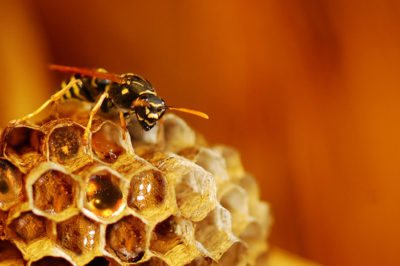
Aspen honey mass is nutritious and high-calorie due to the presence of herbal ingredients in the composition. But such a product does not contain specific enzymes, without which the main property of aspen honey is quickly lost - viscosity. The crystallization process also starts quickly. But after crystallization and drying, the wasp product can still be eaten.
Wasps make honey or not
Wasps, like bees, belong to the same family. Adults also feed on nectar, pollinate flowers, so the question arises - do they make honey. In our area, no one has heard that a striped family is being bred for their own benefit. However, in the countries of Africa, Central America, such an occupation is characteristic of some species. Wasp honey differs from bee honey in quality, quantity, useful properties.
Features of life
To find out whether wasps make honey, you must first figure out whether they need it. In most cases, we are talking about adults. The adults feed on nectar, juices of ripe vegetables and fruits, but for the larvae they get protein food - spiders, flies, small insects, bees.
Wasps prefer to eat honey, but not do it. Many families attack bee hives, completely destroy stocks at a time, and drag the "prisoners" to feed their larvae. Honey is not dragged into the nest, so there is no honey in the honeycomb.
However, a small layer of sticky mass, reminiscent of a beekeeping product, accumulates on the walls of the cells. Again the question is whether wasps make honey or not. Insects do not load themselves with this mission, plaque is obtained by itself, after the insect stays on the flower, feasts on pollen.
In the countries of America, Africa, there are several families of social wasps that collect honey and make it. But not in such quantity as the usual bees, but only in order to feed themselves in winter. To say that wasps don't make honey is also wrong.
It is also important that the wasps of our area do not hibernate in swarms. At the end of summer, they leave the nest, scatter in different directions. With the onset of cold weather, metabolic processes in the body slow down, insects become slow, vulnerable. One part perishes from natural enemies, the other from the cold. Only young fertilized females remain to winter, whose mission will continue in the spring. In winter, insects fall into suspended animation - they simply sleep, do not need food supplies.
Features of wasp honey
If a child of primary school age is given honey by bees or wasps, he will confidently choose the first. This will be correct, since our wasps and honey are incompatible concepts. In tropical countries, children will answer differently, since local aborigines even deliberately destroy the hive to get a treat.
Honey wasps of the species Polybius Occidentalis can produce, accumulate honey, store in combs for the winter. However, they are not able to give in such large quantities as bees. They need a product so as not to die of hunger in winter.
Wasp honey is thick, viscous, differs in composition, but smells good. Most of the composition is pollen. It does not contain useful enzymes, to which mankind is accustomed - a huge amount of proteins, sugars. It doesn't taste as sweet as a bee. It makes no sense to breed a wasp family for honey. Only local aborigines look for wasps, ravage the nests, take their waste products.


Honey wasps of the species Polybius Occidentalis
Benefit
Insects do not produce honey, but they are able to bring a lot of benefit to a person by their vital activity.
An important role is played by the wasp family, destroying a huge number of harmful insects with which a person wages a merciless struggle. If it is located in the corner of the garden, do not touch it. Wasps kill flies, spiders, larvae, small insects, large insects. Freely cope with the bear, beetle and its larvae, bronze.
Many solitary wasps lay eggs on the body of the larva of a large beetle, a spider. Within a few hours, a larva emerges from the egg, digs into the victim's body, begins to eat it from the inside. In conclusion, it pupates, after a while the imago emerges in the form familiar to humans.
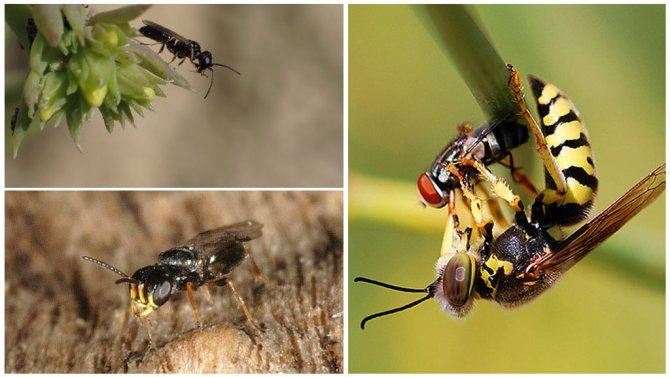

The benefits of wasps
Tiny wasps Spilomena troglodytes destroy thrips. Many other species catch caterpillars of leaf rollers, moths, bedbugs, leaf beetles, cicadas, flies, horseflies, weevils. The functions of a wasp are quite large even without honey - they pollinate plants and increase productivity.
Wasp poison and medicine
Much more interesting for people is not honey, but poison. Relatively recently, scientists discovered the properties of the Brazilian wasp venom to stop the development of cancer cells, to fight the oncology of some organs. It is important that the poison does not affect healthy cells, does not interfere with their functioning.
The Brazilian insect venom contains a unique protein that interacts exclusively with pathological cells, causes their death, and helps to restore the mucous membrane. The poison is effective for cancer of the blood, prostate, bladder. The drug is sold through sites on the Internet, the cost of one capsule is about 9 thousand rubles.
On the basis of the data obtained, studies continue to be carried out, there is a great hope that it will be possible to create an effective cure for cancer, to defeat the disease in a broad sense.
Are wasps able to give honey and how are they useful?
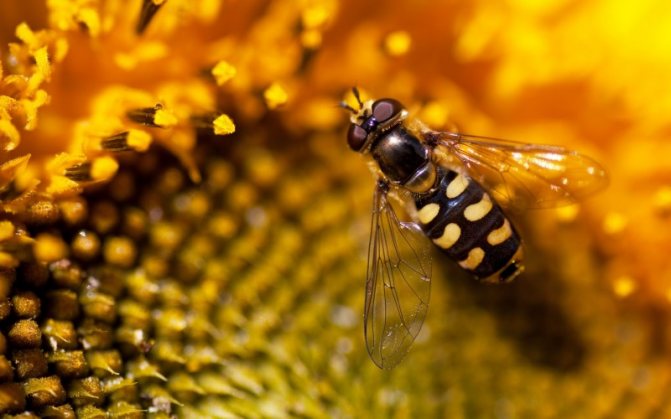

Whether wasps make honey is a controversial and very curious question. Experts say that yes, they do, but not all individuals and not everywhere. Is this so, let's try to find out together.
True or myth?
There are many species of wasps and some of them do accumulate honey in their hives. However, on the territory of Ukraine, Russia and the nearest neighboring states, it is impossible to meet such a “find” in an aspen nest. This is due to the unsuitable climate and the absence of such species of insects that can produce honey. It is known for certain that honey wasps of the species Polybiinae Occidentalis live in the territory of Mexico and the countries of South America.


Polybia Occidentalis accumulates a considerable amount of honey in her hives. This property of yellow-striped was used in ancient times and at present by ethnic Indians living in South and North America. Gathering and bee-keeping were among the oldest occupations of the Mexican and South African Indian tribes. In addition, Polybia is such an ancient species that the idea of feeding on their honey came to the settlers much earlier than the idea of breeding bees.
Otherwise, given the specificity of insects as a species, you can't wait for honey from them, because they give it just enough to feed themselves in winter. Moreover, one should not expect him from ordinary garden dwellers flying over our native spaces.The bloom or napkin in their nests is the result of collecting nectar. They collect less nectar than bees, basically only feeding on it and not storing it. But Polybia prepares food for herself for future use, which is why this species has abundant honey reserves.
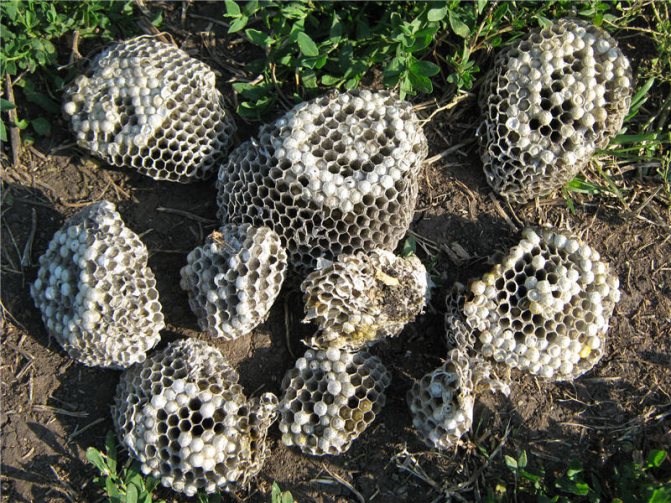

Wasp honey is essentially a very thick nectar. But the enzymes that give bees to their sweetness are not produced in them. By the way, bees communicate with each other in a kind of "language" within a certain neural network. But the wasps do not do anything like that, and in terms of development level they are an order of magnitude lower than their hardworking relatives. Therefore, the concept of "honey wasp" as such for the Slavs did not exist until a more detailed study of this type of insects.
What role do they play?
Despite the futility of honey, wasps are a very important part of the natural fauna. They use pest larvae to feed their offspring. Thus, stinging insects, and so unloved by many, do a good deed for the garden and cultivated plants. For example, a burrowing or earthen wasp is the worst enemy of the bear and their larvae. In order to attract these orderlies to the garden, farmers even plant flowering plants around the perimeter of the garden.
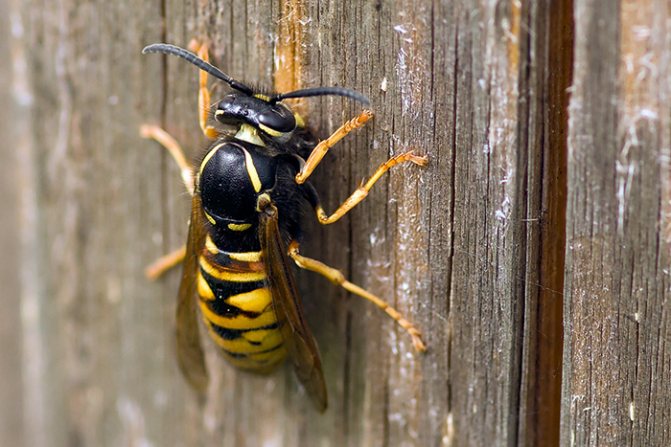

Wasps of the Amorphilla species are also useful - they actively destroy caterpillars of various types. In addition, wall, nosed, paper and large-headed ones perfectly clean the garden of grinders, leaf beetles, flies, cicadas and beetles. As you can see, a dangerous insect benefits nature, crops, and therefore gives a lot of advantages to a person.
These creatures perform the function of pollination, of course, worse than bees, since their natural task is different. But the stings, which everyone fears more than bees, are actually not so dangerous. In terms of the degree of threat to humans, the wasp sting is not far from the bee bite. The wasp poison still exhibits a tonic effect, so you should not be very scared if the wasp stings. The dangerous number of bites for a person is up to 20.
Video "Wasps through the eyes of beekeepers and their wards - bees"
A story about the life of wasps and their role in the life of bees and apiaries. Whether these insects are useful for the work of bee squads and the apiary in general, and what they give to the garden, you will find out by watching an interesting video.
Application
The wasp variety has no special purpose, although it is used in everyday life and in food. Since it is inferior to bee in many respects, it is not very advisable to use it for health improvement.
Most often it is used in cosmetology, for anti-aging creams and masks. The product contains antioxidants, useful components that smooth wrinkles and give the skin elasticity, rejuvenate the face. You can make such a useful mask on your own by mixing a little wasp variety with olive oil and applying the mixture to your face for 20 minutes.
Now we know who makes honey besides bees. This information can be useful for those who come across an exotic wasp variety in stores and markets. It should be borne in mind that in Russia wasps harvest very little honey, only for food, so there will be no large harvests. Do not believe fakes, it is better to buy honey from America or classic bee honey.
The truth about how wasps and bees make honey
Bees and wasps are representatives of one of the largest orders of insects - Hymenoptera. Representatives of this family are characterized by cohabitation, nursing offspring (their larvae), and the division of responsibilities between family members. This is where the similarities between wasps and bees end. We can talk about the differences for a very long time, let's start with how they make honey.
Wasps of the species Polybius Occidentalis accumulate a considerable amount of honey in their hives.
Do wasps make honey
The wasp's ability to produce honey is a very common issue on the Internet. Answering it, the majority is of the opinion that wasps do not make honey, but are only able to eat and feed their larvae with it.There is some truth here, but this is by no means the case. Why we will tell you now. Experts in the field of beekeeping argue that there are certain types of wasps that are capable of not only eating, but also producing honey. Only the habitat of these insects is far beyond the borders of Russia and other nearby states.
The honey-bearing species of such a wasp is found in distant countries of South America and Mexico. It is here that Polybia Occidentalis (Polybiinae Occidentalis) lives. An individual of this species collects honey nectar with great success, accumulates honey nectar in its hives, eats and feeds its offspring (larvae) with it. Science knows that since ancient times the peoples living on the territory of these states were fed with polybial honey.
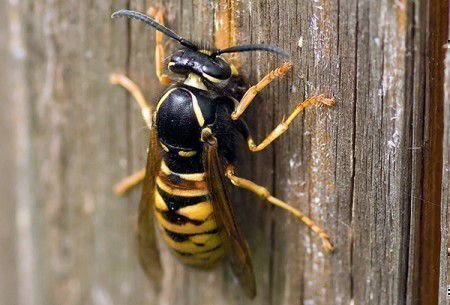

Wasps of the Amorphilla species actively destroy caterpillars of various species
The inhabitants of our latitudes are incapable of accumulating honey in their hives. The nectar on the walls of their dwellings (spray) is just a thin bloom of honey. Its quantity is so small that it is enough only to feed the wasps themselves and feed the larvae. Moreover, it is known that they mainly extract nectar not for harvesting, but in order to eat. The taste of nectar differs significantly from the usual honey, mainly in that it is not so sweet and thicker.
Despite the lack of honey-making skills, wasps are very useful for the fauna. Their main merit is that they destroy many pests and their larvae that live in gardens and vegetable gardens. For example, an earthen wasp eats a bear with their larvae. Another species (Amorphillus) feeds on flies, grinders, leaf beetles, cicadas. That is why knowledgeable gardeners love representatives of this family, luring them into their lands with fragrant flowers.
The pollination ability of a wasp is somewhat worse than that of a bee, but it still does this function. Among other things, do not be afraid of her bite. The tonic effect manifested after a bite is beneficial for humans. If it does not exceed the permissible amount (more than 20).
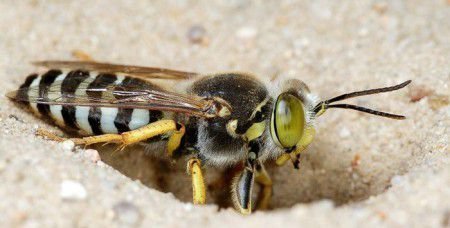

Earth wasps are eaten by a bear with their larvae
How bees make honey
In contrast to their fellows, hardworking bees are an order of magnitude higher. This is confirmed by the neural network - the language of communication between insects. All responsibilities for the collection, acceptance, further reproduction and feeding of the offspring (larvae) in the hive are strictly distributed. The toiler bee not only produces a large amount of honey of different varieties, eats herself and feeds her offspring with it.
The main sources of nectar production are various trees, flowers and shrubs. It is from the plant from which the pollen is collected that the taste of the honey produced will depend. Which we will eat on winter evenings. The process of how bees make honey is conventionally divided into the following stages.
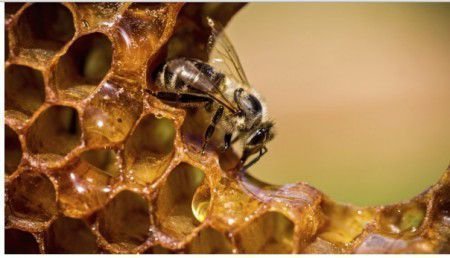

Bee at work
- With the arrival of spring and the blooming of the first flowers, the time for collecting nectar begins. Scout bees set off in search of suitable plants. Moreover, we note - they are only looking for places and take pollen for a sample. Insects-collectors will collect honey nectar after the scouts inform them and direct them towards the collection point.
- Bees collect nectar with the help of a proboscis, which, in fact, the wasp does not have. Which gives them another advantage. The taste buds located on the legs help it determine if there is pollen on the plant. During the collection, the bee places the found nectar into its mouth, where the processes of production of special enzymes take place with the help of the secretion of the salivary glands. This process is very important in all phases of honey nectar production.
- Acceptance and further processing of the collected product is carried out by the receiving bees. They place the product in the cells of the honeycomb, then the process of honey processing begins. It is critical in the chain as the quality of the honey depends on it. First of all, insects lay out honey in honeycombs, and so that they are only a quarter full.Such proportions enable water to evaporate correctly and quickly. The nectar then moves to the top walls of the cells and the hive is well ventilated to remove water vapor. In the process of thickening honey, bees transfer it from one honeycomb to another many times. Last but not least, the ripening honey is placed in the top of the combs, filling them up to the top.
- The final stage in the preparation of honey by bees is to seal the cells with the honeycomb with wax caps. The moisture content of honey (water content) at this moment should be no more than 21%. Only such a product can be of high quality and ready to use.
Scolia wasps
Scolias are representatives of one of the most numerous family of wasps. These insects reach a size of 6 mm to 10 cm, females are much larger and more hardy than males. In females of some species, the tips of the wings are colored purple, the body is black with yellow, white or orange spots. Scoliosis wasps lead a solitary life and feed on flower nectar. Their offspring are fed with the larvae of other insects.
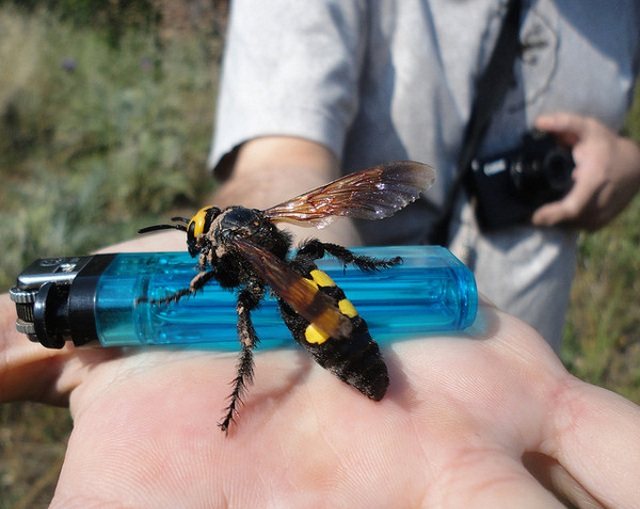

Despite its impressive size, meeting with this species is almost not dangerous, these wasps sting not so painfully, and the poison is not very toxic. Moreover, these wasps prefer not to come into conflict upon contact with humans and destroy harmful insects. Also, wasp venom is often used in medicine.
Wasp honey and honey wasps - truth or fiction?
Does wasp honey exist, or can such a phrase be used only as a phraseological unit, as something impossible? Could any other insect at all have the unique ability of bees to transform flower nectar into a wholesome food product?
Yes, there are little known subfamilies of wasps that make honey in their nests. These unusual insects live in Mexico, Argentina and South America. One of the species is called the Mexican Honey Wasp (scientific name - Brachygastra mellifica). Another species is Polybiinae Occidentalis, these wasps are common in the southern United States, in the American tropics.
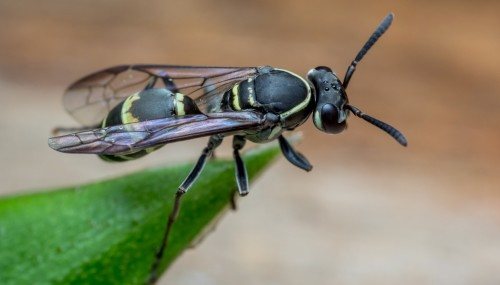

Honey wasps are the oldest insects. And although the level of their evolutionary development is much lower than that of bees, the indigenous tribes of the American continent have feasted on their honey for many centuries. The collection of this delicacy can be called a primitive form of beekeeping that preceded modern beekeeping. And now there are also people who are familiar with the taste of wasps honey.
What does wasp honey taste like and why can't you find it on sale?
Unlike bees, which produce a large amount of honey in the warm months of the year, honey wasps store so little sweet nectar in their nests that they only have enough of it for their own food in the winter months. It will not be possible to get a really large amount of honey from wasps, even if you gradually take away their reserves (as is done with bees), because wasps are not able to work as hard as bees.
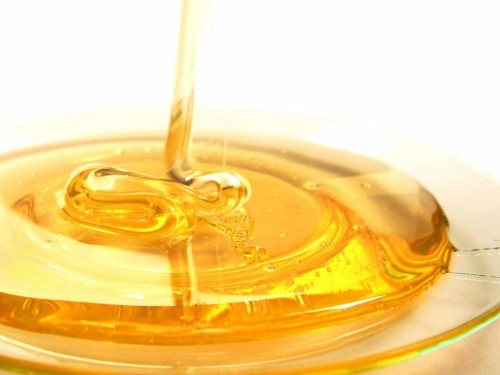

Wasp honey is essentially a very thick, sweetish mixture of pollen and nectar with a rich floral aroma, containing many nutritious plant components. Wasps, like bees, fly around all flowering plants available to them in the area, trying to find food sources closest to their nest. Therefore, the taste of honey largely depends on those plants that grow near their home.
Despite the pleasant taste and smell, wasp honey is in many ways inferior to bee honey, and its nutritional value is low. It does not contain those enzymes with the help of which the bees transform the collected nectar into honey familiar to our taste buds, in addition, it quickly loses its viscosity and crystallizes. Wasp honey is nowhere near as sweet, and certainly not as healthy. In fact, it almost does not differ from the original nectar that contains the flower bud.
Is it possible to find on the territory of Russia
Among the Slavs and other peoples inhabiting the territory of modern Russia, the concept of "wasp honey" never existed. This phrase was used only in a figurative sense, and was also used to name light alcoholic beverages based on bee honey.
The climate of Russia and other countries close to it is not suitable for honey wasps. However, in the nests of ordinary paper wasps that are well known to us, you can sometimes find a very thin sweet bloom - the result of the collection of flower nectar and fruit juice by these insects. But the total weight of sweet stocks is negligible, at best it is several tens of grams.
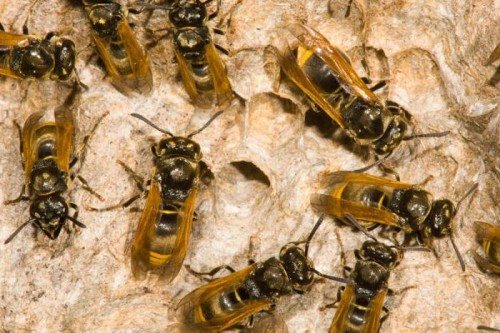

This "honey" spray is formed on the combs by chance, since wasps also extract pollen and nectar for their own food, and they bring part of this sweetness on their paws to the nest. But bumblebees deliberately store a small amount of pollen in case of bad days, when there is no way to feast on it directly from the flower.
The nectar collected by wasps and bumblebees gradually "ripens", turning into a product similar to honey. Analysis of wasp and bumblebee honey showed that it mostly consists of pollen, quite a lot of calcium, protein, sucrose and minerals in it. However, those wishing to eat it should be careful - sometimes insects collect pollen from plants poisonous to humans.
Brachygastra lecheguana
The fold-winged family, which includes wasps, is very numerous. Among them there are also predators - leafy ones. Unlike our yellow-black wasps, they lead a group lifestyle, and in the swarm they have clearly assigned responsibilities. As in the bee hive, the polys have a queen that lays eggs, drones and many working wasps: builders, hunters, guards for larvae. But there is a melliferous species among the predators. It is called Brachygastra lecheguana. These wasps live in the United States, their range extends to the south of Texas. Their honeycombs are very unusual: they are wrapped around the outside with a paper cover. Like all leafy ones, they also feed on insects, but lay wasp honey in their nests. About fifteen thousand individuals live in one such swarm. This species of wasps likes to nest in the crowns of citrus trees. The "bee" way of life of the Brachygastra species is all the more surprising because their ancestors were exceptional meat eaters.

